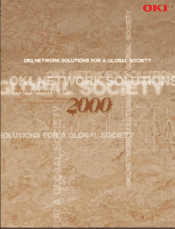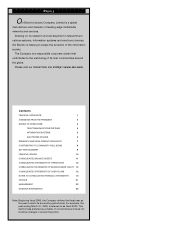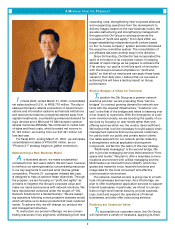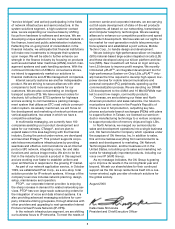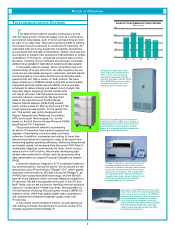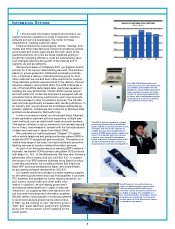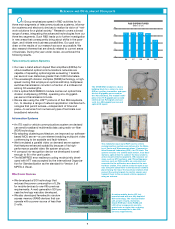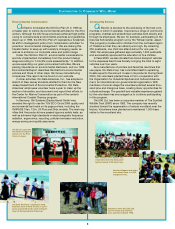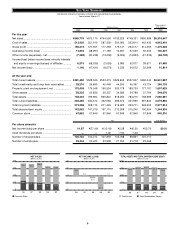Oki 2000 Annual Report Download - page 9
Download and view the complete annual report
Please find page 9 of the 2000 Oki annual report below. You can navigate through the pages in the report by either clicking on the pages listed below, or by using the keyword search tool below to find specific information within the annual report.
7
Oki Group emphasizes speed in R&D activities for its
three main segments of telecommunications systems, informa-
tion systems and electronic devices to realize its vision of “net-
work solutions for a global society.” Research covers a broad
range of areas, integrating the advanced technologies from our
three key segments. Such R&D leads us to further investigation
in new areas that consequently bring about shifts in the para-
digm, and initiate new business possibilities. Our goal is to
draw on the results of our research as soon as possible. We
also research themes that are directly related to current areas
of business. During the year under review, we achieved the
following results.
Telecommunications Systems
• Our new L-band erbium doped fiber amplifiers (EDFAs) for
ultra-broadband optical communications networks are
capable of repeating optical signals exceeding 1 terabits
per second over distances greater than 3,000 kilometers.
• The wavelength division multiplex (WDM) technology, a high-
speed routing that employs an optical add/drop multiplexer,
switches transmission circuits in a fraction of a millisecond
among 32 wavelengths.
• Oki’s optical MUX/DEMUX module carries out optical time
division multiplexing (OTDM), operating at a 40-gigabit-
per-second transmission bit-rate.
• We are also using the JINI™ protocol of Sun Microsystems,
Inc., to develop a range of network application interface tech-
nologies that permit access—independent of time and
place—to services from numerous types of terminals over
broadband networks.
Information Systems
• An ITS road to vehicle communications system we devised
can send broadband multimedia data using radio-on-fiber
(ROF) technology.
• By adopting clustering architecture, we improved our software-
based MCU server—a core element enabling multipoint video
conferencing to be scalable and fault-tolerant.
• We formulated a parallel video on demand server system
that features enhanced scalability because of its high-
performance parallel video file system structure.
• A compact iris-recognition device we developed is small
enough to fit in the user’s palm.
• The NEWPRED error resilience coding mode jointly devel-
oped with NTT was accepted by the International Organiza-
tion for Standardization as the standard for Version 2 of
MPEG-4 Visual.
Electronic Devices
• We developed a SOI technology that
reduces the power consumption of LSIs
for mobile devices to one-fifth previous
requirements. A next-generation SOI pro-
cess technology was also developed.
• We also developed ferroelectric random
access memory (RAM) devices that can
operate with a power source of less than
2 volts.
RESEARCH AND DEVELOPMENT HIGHLIGHTS
A custom mobile device LSI test
manufactured with our fully depleted
SOI technology. The microcontroller
unit, power circuits, memories
(mask ROM and static RAM) and
LCD driver components are inte-
grated onto a single chip, reducing
power consumption to one-fifth
previous requirements.
This millimeter-wave band ROF road to vehicle
communications system was delivered to the Minis-
try of Posts and Telecommunications’ Communica-
tions Research Laboratory (CRL), for ITS trials. The
system consists of a central base station, local base
stations, optical fiber to connect the base stations
and on-board vehicle equipment. ITS exclusive ser-
vices, such as ETC systems, and ITS multipurpose
services, such as PHS and BS, are collected and
converted to the millimeter-wave band at the cen-
tral base station. This station sends the optical sig-
nals along the optical fiber to the local base stations
placed along the road. The local base stations then
convert the optical signals to electric signals and
transmit them to the on-board vehicle equipment
using an antenna.
The OTDM MUX module is a basic
building block for a return-to-zero
(RZ) or a soliton transmitter and oper-
ates at 40 gigabits per second (or
OC-768 standard). The module multi-
plexes two 19.9-gigabit-per-second
electrical non-RZ signals and con-
verts to a 39.8-gigabit-per-second
optical RZ signal.
41.8 41.9 42.4 40.9
R&D EXPENDITURES
(Billions of yen)
29.5
0096 97 98 99
48
36
24
12
0

